Stu’s comment: Tim was good enough to take photos, make notes, and generally do everything else needed to document his Superior Super88 kit installation so that it could be shared with everyone. Since Tim and I don’t live anywhere near each other, he also got stuck doing this write-up, mostly because he wouldn’t fly me up to his place to help out! I promised him I would host the write-up here so as many folks as possible could easily find it. A big thanks to Tim for sharing his comments and hard work.
OK……now on with Tim’s write-up.
If you are looking to get even more strength out of that Ford Explorer 8.8 axle you swapped into your Jeep, this write-up is for you. This kit will make your 8.8 laugh at 37 tires.
The Super 88 kit can be easily installed with common tools. A few wrenches, hacksaw and file to name a few. Anything else is just a luxury but totally not necessary. The kit requires some cutting and no welding. It bolts on in your driveway in 2 hours.
The new rolled splined and CNC-Machined axle shafts are 4340 induction hardened chromos with a breaking strength of about 9500 psi. They have a thicker flange and shaft body for tons more strength. The Timken bearings in this kit are the common “Set 20″ these bearings offer twice the strength of your regular roller bearings.
While eliminating the c-clips, the Super 88 kit widens the axle by about .96″ on each side by installing a housing end adapter. It use the same SET-20 bearing that Currie uses in their 9″ and Dana 60 housings ends. It is also the same one that Dynatrac uses on their Custom built Dana 60’s. This kit will widen the 8.8s track beyond the stock Dana 35 axle that came on your rig to 61-3/8” (wms to wms) and bring it closer to the front axle’s width even if your Jeep has a manual locking hub kit up there.
Onward:
A few days ago there was a dead UPS man on my doorstep under a 50 lb. package with “Superior” stamped all over it. Anyone who has been to my home knows how steep the driveway is. Let’s just say I live in the city and I don’t get trick-or-treaters or solicitors because I live on “Cardiac Hill”. UPS, FedEx, etc. they hate me.

Here is what comes with the Super 88 kit:
(2) 4340 Chrome Molly axles (Made in the U.S.A with American steel)
(2) Retainers w/spacer rings.
(2) Timken bearings/seals.
(10) threaded studs and locking nuts.
(8) Set-up nuts
(2) Housing end adapters.
(2) Superior axle badges.
All hardware and instructions needed to put the kit together.
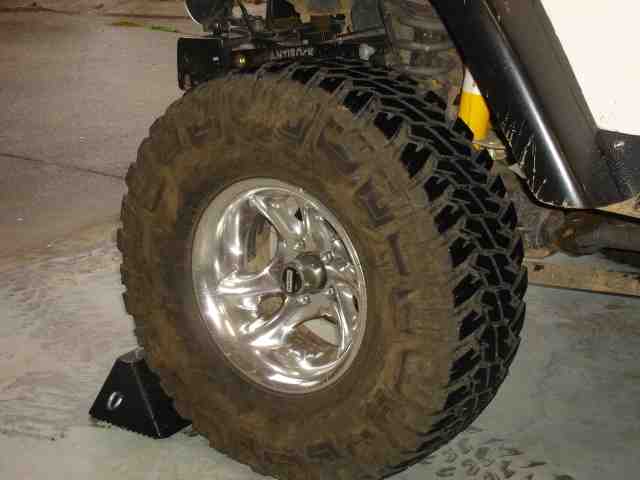
Before you get started just remember your personal protection equipment. This includes eyes, ears, gloves and things like jack stands and wheel chocks. I like to fling sparks as far as possible with my man tools so I keep a fire extinguisher handy too.
As I mentioned before, this kit is designed to be easily installed in one’s driveway, even if you only have a hacksaw and file. But I say “Why fight technology?” Grandpa had it rough and power tools were put on Earth for good reason. Look at it this way, if the power goes out the Super 88 show still goes on.
Here is a list of tools I used:
– 19mm (lug nuts)
– Breaker bar
– Flat head screw drivers
– Floor jack
– Wheel chocks
– socket (diff cover removal)
– Scraper
– 10mm (caliper bolts)
– Bungee cords (hang calipers out of way)
– 5mm allen wrench (ARB cross pin)
– Telescopic magnet (c-clip retrieval)
– L.E.D. headlight (you want to see right?)
– Rubber sand mallet (removing disc from old shafts)
– 14mm (backing plates and housing end adapters)
– Needle nose pliers (bearing cage)
– Slide hammer (you really need this unless you want to cuss a lot)
– Angle grinder with cut off wheel and tiger flap disc
– Emery cloth
– Drain pans
– Wire brush or wheel
– Silicone sealer (I used Permatex “the Right Stuff” and “Ultra Grey”)
– Diff fluid
Yeah, I used a lot of tools but some people like shoes and I think THEY have a problem. I like tools.
Getting on with it:

The c-clips need to come out to remove the stock axles but first the differential cover must come off in order for that to happen. So, crack that diff open and get the “big nasty” out of the way. That thing will drain forever and you can let it drain while you are chocking up the front wheels, setting up the jack stands under the rear axle and removing the wheels and tires. While you are at it, grab that 10mm wrench and remove the caliper bolts and hang them out of the way with your bungee cords or zip ties.
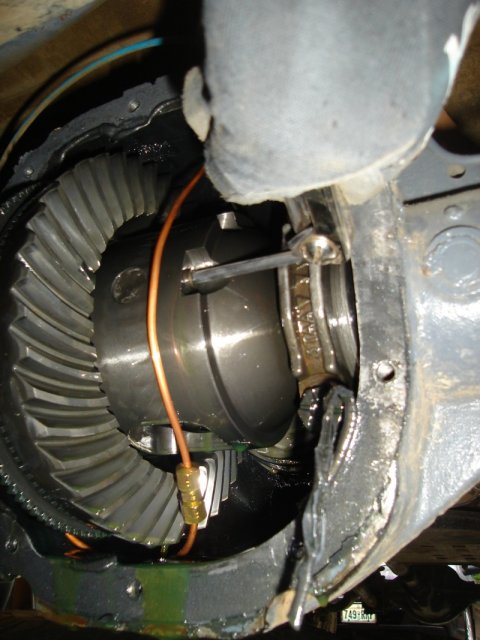
It is time to get the c-clips out. So you can get the axle shafts out, so you can stick the other ones in. See where I am going? If you have an ARB locker in the 8.8, you will also most definitely have a 5mm Allen wrench to get that cross pin retainer bolt out. Once the bolt is out, the cross pin can be slid out of the way for c-clip removal.

For the next step put the transmission in neutral and have the parking brake off. You will need to spin the ARB locker around. Push the pin out towards the retainer bolt end of the cross pin. Rotate the locker around until you can see into the access window. Have a minion (or just get up) push the axle shafts inward to take some pressure off the c-clips. I tapped the axle shafts on the end with my rubber mallet and dislodged the c-clips which I pulled out with a telescopic magnet.
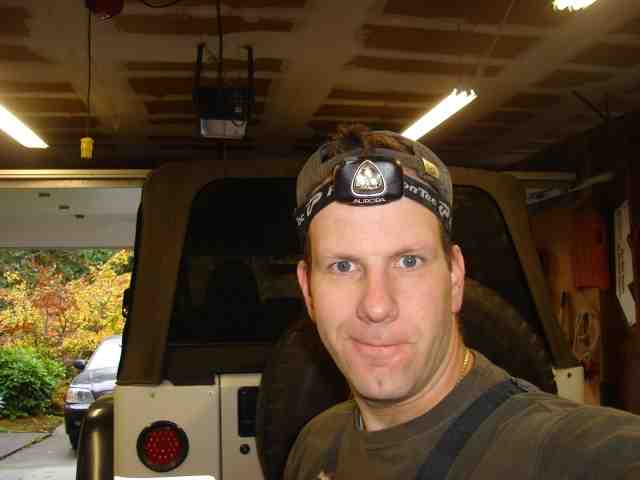
This is my head with a L.E.D. headlight. If the power goes out and I have to find my hacksaw and file I am set! Really, its one of the best tools I have. I don’t wear it to bed or to dinner, I think it would make my bride angry.
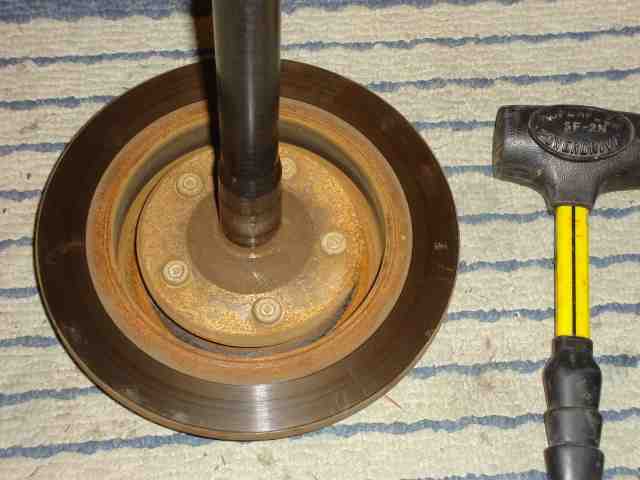
The rotors may be stuck on the old shafts and so you will have to tap them with something. This rubber dead blow hammer is perfect for this. I chose to do it on the door mat so I wouldn’t damage the threads on the studs. True, I could never use these shafts on my current 8.8 again but, I have a good friend who I have poisoned with the thoughts of having his own Ford 8.8 someday. I will keep them long enough to make sure his find doesn’t have anything wobbling that shouldn’t wobble (or until his Super 88 is installed). I am betting it will be found in a salvage yard. Bent shafts are like a social disease in the “pick-a-part”.
Here is an opportunity to inspect and replace worn brake parts. If you have your “Jeep minion” at your side, send him/her with a list to the local parts monkey for your needed items. It will be a while before you get back to the brakes anyways.
Now is a good time to stuff a clean, lint free rag in each axle tube end to keep metal shavings and debris out.
The caliper bracket comes off with a 14mm socket. Don’t worry, it all comes off in one piece so you don’t need to pull springs, shoes, etc… The back side has nuts with a retainer on them so you don’t need a wrench back there. I just zipped them right off with my impact. The caliper bracket will hang nicely out of the way. Get yourself a small catch basin like a coffee can or something to catch busted parts and diff fluid. Once you pull that seal off, there will be fluid running out the end of the axle tube.

Pry that bearing cage up with a pick or small flat head screw driver then yank it out with some pliers. A magnet works good to get the roller bearings out. Now this is the part where you can move along quick like a dragonfly or slow like a chick movie. You will want that slide hammer. So forgo the frustration and come back when you have it. The alternative is a chisel and a smashed hand from each time you hit it with the hammer.
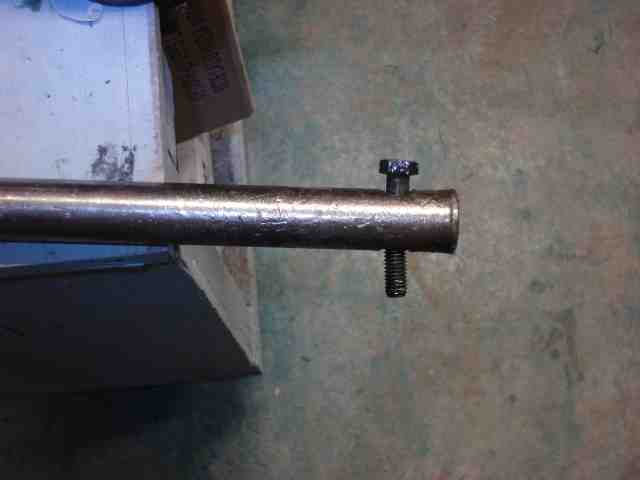
I made my own out of a 1″ diameter shaft (solid steel) and a bolt. It worked real well except the bolt doesn’t look as happy and youthful as it did before the abuse.
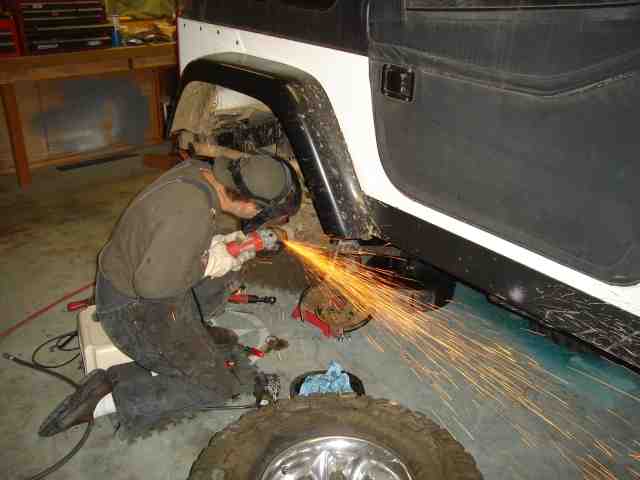
Cutting off the snout….
This is the most critical step for a successful installation. Take great care in doing this correctly. The snout must be cut down exactly even and flush with the existing caliper bracket centering shoulder.
Here I am (in above photo) trying to hurt myself while cutting off the snout. Again, make sure you leave the shoulder for the housing end adapter to mount upon and seal. Make accurate cuts and take your time. Most of all, be safe in this awkward cutting position. You can use a file or a “tiger disc” flap style wheel on your grinder to bring the edge down flush and square with the shoulder you need to keep for mounting and sealing purposes. Take a round file, emery cloth or a de-burring tool and clean up the inner edge to help with the next step.
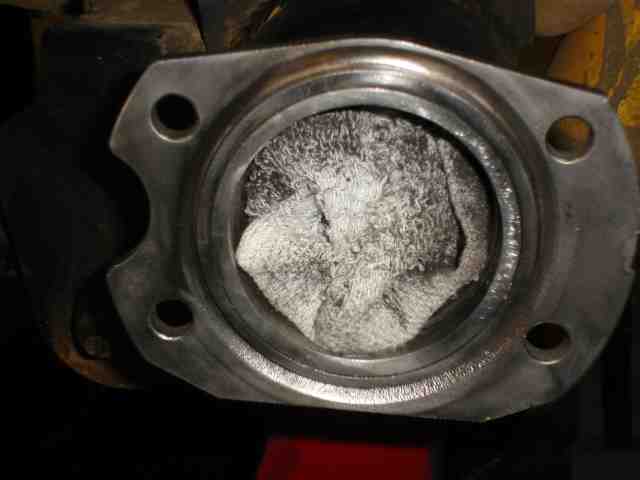
All cleaned up and ready to mount up the housing end adapter. This area should be free of all rust and corrosion at this point. A wire wheel or brush will make short work of this.
More Super88
Superior Axle and Gears Super88 Kit
by Tim Doumit
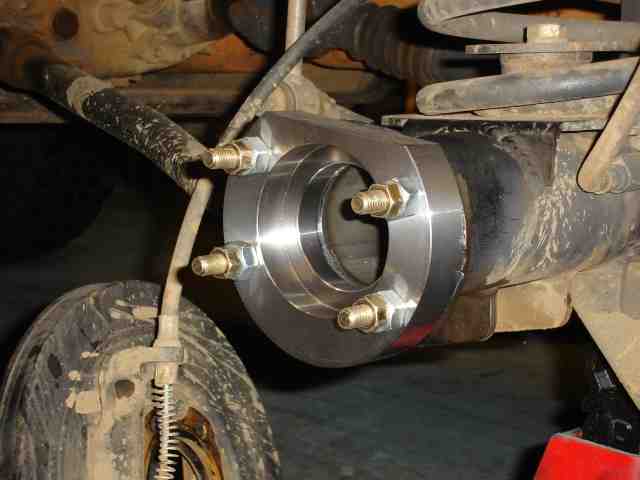
On the back side of the housing end adapter there is a recess which you will apply a bead of silicone sealer. I used Permatex “The Right Stuff”. In all the times I have put diff covers back on I have never had a leak with this product. Use the mounting bolts and set-up nuts for the installation of the adapter flange. Slide the housing end adapter onto the bolts and line up with the axle tube. There are four large 7/16″ nuts that slip on first and four smaller 3/8″ non-locking set-up nuts to press the unit on. Do not use the 3/8″ locking nuts at this time, they are for final assembly after the shafts are slid into place.
Once you have adapter flange set squarely on the flange and the indexing neck / ring lined up to slide inside the tube, begin tightening the nuts with a deep 14mm socket and a 14mm end wrench on the back. Use a cross pattern and bring the housing end adapter tight against the flange evenly. Make sure you check your progress as you go to ensure an even installation. Once in place remove the nuts and do the other side.
The caliper bracket / dust shield assembly is next. To ease reinstallation of this assembly onto the axle it is a good idea to drill the dust shield holes out to the next biggest size. My caliper bracket holes were already bigger. The size of the holes and style of the dust shields may vary a bit.
The same goes for the center hole where the bearings will pass through. Test fit the assembly and see where the dust shield will sit in relation to the caliper bracket, then use a file or small grinding stone on a die grinder to enlarge the opening to match the caliper bracket. After you have the caliper bracket and dust shield in place, it’s time to install the axle shaft. Pull the rags out and clean the axle tubes thoroughly of debris and metal shavings.
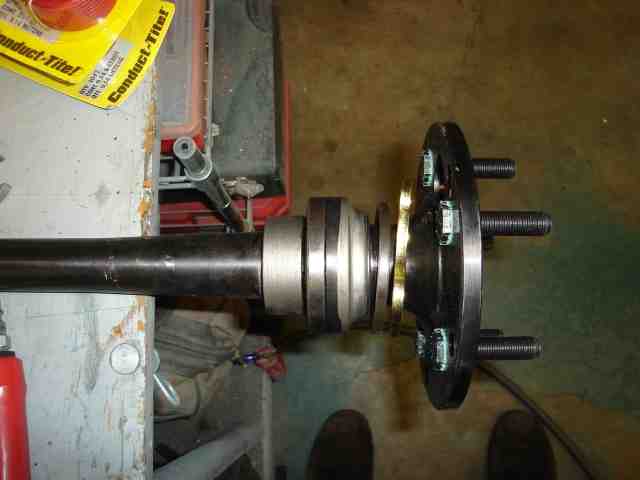
(This next step you may or may not have to do as the kit may start coming soon with the bearings already pressed on.)
First you must have the bearings pressed on. (Unless you have a 20 ton press in your shop. I do not and my 12 ton Harbor Freight press was not up to the task.) I took the bearings, seals, retainer plates, rings, collars and shafts to my local automotive machine shop to let the experts do their thing. This might cost you a few bucks but it is worth it. If you choose to do it on your own you may want to press the bearing on first and then the collar. (Remember the retainer plate goes on first, next the ring, then the seal, bearing, collar.)
Install your studs into the flanges. Make sure you select the right bolt pattern. If your Jeep is running stock bolt pattern wheels, use the inner threaded set for 5 on 4 1/2. Dab some blue thread locker on the threads during installation.
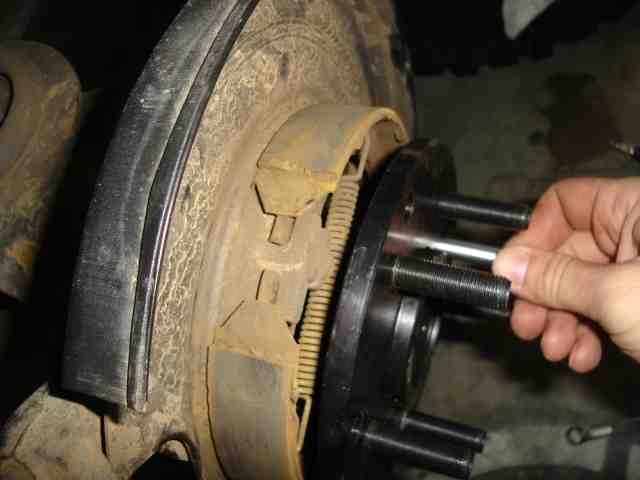
Okay, you have your assembled shafts (long shaft on driver’s side and the short goes on the passenger side). I put a little grease on the splines and a thin coat of Permatex “Ultra Grey” silicon on the seal’s edge. Slide the axle into the tube and line up the retainer plate with the bolts (you took your rags out, right?). Use your Grade-C locking nuts for final assembly and tighten them down to 50 ft lbs. (it might be a good idea to tighten them in a cross pattern working your way up to 50 ft lbs.)
The rotors and calipers are next: Make sure your rotors are free from grease and oil before they come in contact with your brake pads and shoes. Do not over torque your caliper bolts. Retighten to factory specifications.
Seal up you differential and refill. Put on some wheels and tires and you are done!

